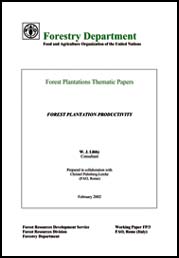 W. J. Libby
W. J. LibbyConsultant
Working Paper FP/3
Forest Plantations Thematic Papers
Prepared in collaboration with
Christel Palmberg-Lerche
(FAO, Rome)
 W. J. Libby
W. J. LibbyForest Plantations Thematic Papers
Prepared in collaboration with
Christel Palmberg-Lerche
(FAO, Rome)
Forestry Department
Food and Agriculture Organization of the United Nations
February 2002
Forest Resources Development Service
Forest Resources Division
Forestry Department
FAO, Rome (Italy)
1.1. The need for wood, wood products, and other forest services.
1.2. Forest plantations or indigenous forests?
2.0. FACTORS AFFECTING FOREST PLANTATION PRODUCTIVITY
2.1. Access
2.2. Site selection
2.3. Species choice
2.4. Genetic inputs2.4.1. Adaptation and allocation
2.4.2. Breadth of adaptedness
2.4.3. Avoidance of both inbreeding and dysgenic selection2.5. Nursery practices
2.6. Site preparation
2.7. Spacing and age control
2.8. Planting
2.9. Post-planting care
2.10. Soil moisture and fertility
2.11. Thinning and pruning
2.12. Holistic management
2.13. Biological diversity considerations
2.14. Carbon-credit considerations
3.1. General gains from choice of species and provenance
3.2. New Zealand
3.3. Australia
3.4. China
3.5. Europe
3.6. Colombia
3.7. USA3.7.1. California
3.7.2. Second generation seed orchards of Pinus taeda
3.7.3. Gum yields of Pinus elliottii